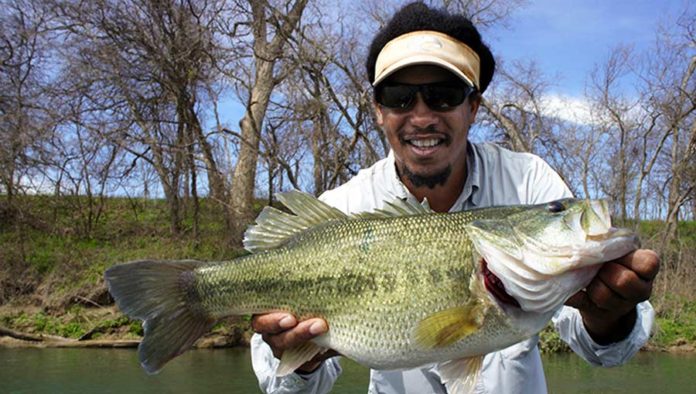Few things in fly-fishing are as exciting as watching a largemouth bass smash a fly on the surface, and Alvin Dedeaux of All Water Guides gets to watch this spectacle more than most anglers. Based in Austin, Texas, Dedeaux was a 2016 Orvis-Endorsed Guide of the Year Finalist, has appeared on Tom Rosenbauer’s Fly Fishing Guide Podcast, and is a a former Trout Bum of the Week. Last year, he shared his Top 5 Subsurface Flies, so this list makes a great Top 10.
When he’s choosing a topwater pattern, Dedeaux says that water clarity is important. If the water is dirty, he uses flies that make a lot of noise, whereas in clear water, he prefers frog patterns that swim on the surface and are less likely to spook the fish. Here’s what Alvin has to say about each of his favorite patterns:

1. Cohen’s Frog-Legged Diver
This fly is great both wet and dry. Some days, I like to fish it by giving a couple of good, hard pops and then letting the frog come to the surface. Other days, I get the frog soaked with water so it swims below the surface.

2. Dancing Frog
When fishing this pattern, I slap it down and fish it one of two ways: with a pretty quick nonstop retrieve or, if the fish aren’t hitting it, with really long pauses in between strips to let the fish find the fly.

3. Blados Crease Fly (baitfish color)
I usually fish Crease Flies on a floating line, especially above submerged weeds or grass in the water. The fly hits the water with a big splash, so I tend to lay it down with a couple of big pops and then quickly strip it in to get the fish really fired up. An all-white Crease Fly can also be very productive.

4. Hair Bass Bug
I would recommend any deer-hair bass bug, no matter the color, when you’re fishing for largemouth bass. Yellow, red-and-black, or yellow-and-white–whatever color you have or want to throw out there will probably work.

5. Bass Popper
The nice thing about hard-body bass poppers is that they never get water-logged. I also find them to be a little more durable in the long run. Some of the deer-hair patterns above can get pretty soggy, which makes them harder to cast or sit too low in the water. Hard-body poppers also make a lot of noise when they hit the water, so you don’t need to put in as much effort as you would with the deer hair flies.
Credit: Source link































